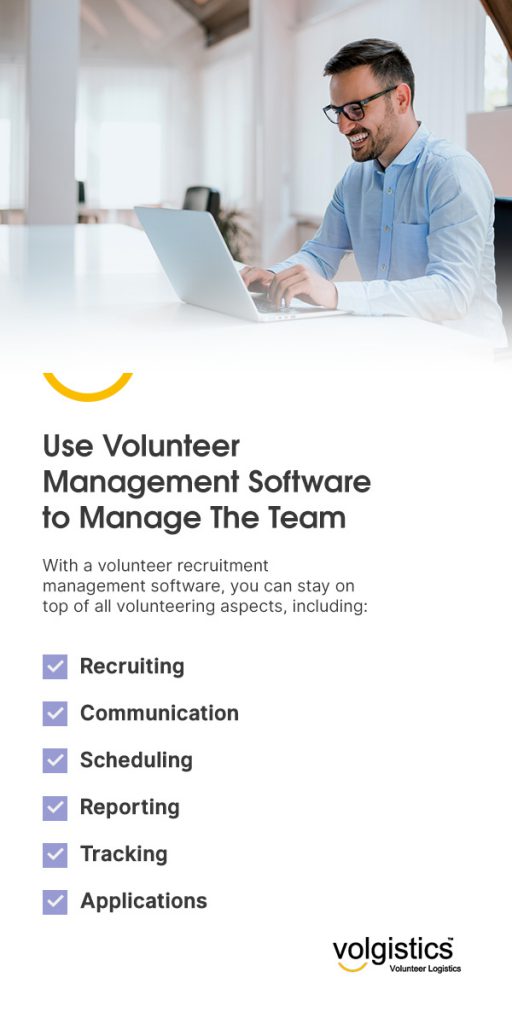Over the last few years, millions of people have shifted to a virtual environment for school, work, and health appointments. This shift is no different in the nonprofit sector, as many volunteers search for ways to engage with their favorite organizations through an online presence.
While this method of volunteer engagement may seem difficult to sustain, introducing hybrid and remote workflows to your team provides more flexibility, resiliency, and accessibility. Whether you need volunteers to mentor, write cards, translate, or provide hotline support, having hybrid and remote volunteers lets you grow your capabilities and serve your community more than ever before.
Benefits of Working With an In-Person, Hybrid, and Remote Volunteer Team
While leading hybrid volunteer teams has its challenges, there are endless benefits to having a blended team of supporters. Having in-person, hybrid, and remote volunteers for your volunteer organization allows you to expand your reach, engage your community, and make it easier for members to provide even the smallest acts of service from any location.
Here are some of the most significant benefits of working with these multi-faceted teams:
Expand Your Volunteer Base
One of the most apparent benefits of working with virtual and in-person volunteers is expanding your volunteer base. If your organization needs more supporters, hybrid and remote volunteers are a great way to reach out to more people looking to contribute to your cause.
Your volunteer organization may be based in a small community or have an upcoming annual event requiring more help. Finding remote and hybrid volunteers lets you work with many people who may not live in your community or state but want to devote their time and energy to your mission.
Make Use of All Skillsets
Expanding your volunteer base by bringing on hybrid and remote volunteers enables you to choose from a wider pool of skills from your team members. There are many new skills and qualities that remote, hybrid, and in-person volunteers can bring to the team, including:
- Leadership
- Time management
- Communication
- Computer skills
- Creativity
- Organization
- Problem-solving and adaptability
With volunteers present at your facility and those dedicating their time remotely, you can easily highlight each team member’s skills, engage more highly skilled and experienced volunteers, and place them where they will thrive.
Whether you’re holding an online event that your tech-savvy volunteers can handle or need an in-person member to help with your fundraiser, your remote, hybrid, and in-person volunteers can feel more connected as their skills and achievements are recognized.
Interact From Anywhere
One of the most important benefits of having a mix of in-person and remote volunteers is you don’t need to have every volunteer in the same room at the same time to communicate. This gives your team maximum flexibility and provides more opportunities for a broader network of supportive peers and staff.
On your online communities, volunteers can access any learning resources or event information right when they need them, without meeting in person to ask questions or understand what needs to be done. Allowing your volunteers to interact with learning modules and organization information from anywhere can build a stronger connection with your mission and foster a greater sense of achievement when they reach their goals.
Increase Accessibility and Build Resiliency

For nonprofit organizations to thrive, it’s critical to diversify engagement opportunities. Having a varied set of volunteers lets you provide meaningful experiences no matter how your staff chooses to interact with your mission. Whether they’re directly in your community or across the country, offering hybrid and remote options increases your accessibility worldwide.
In addition, providing different ways for volunteers to engage remotely allows your team to contribute to your organization if they are traveling, sick, or unable to make it in person. Over time, this will help your organization become resilient to common issues that can make or break your growth and success.
How to Build a Team of In-Person, Hybrid, and Remote Volunteers
Now that you know the many benefits of having in-person, hybrid, and remote volunteers, let’s look at how you can build this team.
Set Expectations for Each Role
One of the first steps to attracting — and retaining — volunteers for every type of role is to set proper expectations. Setting clear expectations from the beginning helps your volunteers know exactly what their responsibilities are and how they can prepare for their duties. Some of these early expectations can include:
- Providing detailed role descriptions.
- Establishing an explicit schedule for all volunteers.
- Outlining general responsibilities, such as attendance, attire, and conduct.
- Offering plenty of communication channels for members to get in touch.
When volunteers know what you expect of them from the very moment they engage with your volunteer organization, they will feel more prepared and ready to take on any new event or fundraiser. Understanding their duties will also help them feel more confident in their abilities and skills as they strive to meet their goals. Additionally, remote and hybrid volunteers appreciate being just as valued and feel like their time is being well-used.
Setting expectations ahead of time makes it easier for you to keep every role within reasonable skill ranges and helps you stay organized. There will be different requirements and responsibilities for every position in your organization.
No matter how your volunteers choose to interact, it’s important to assign jobs that fit everyone’s abilities so they can feel properly valued and recognized for their work. When you set realistic expectations right away, it can help you handle and manage volunteer expectations just as efficiently.
Rethink Training for Roles
While you might have an established orientation, onboarding, or training program for in-person volunteers, you may need to get creative when it comes to your hybrid teams and remote workers. For example, training an in-person volunteer for a particular role in your upcoming fundraiser might be challenging to conduct over a video conference without the right tools and resources.
If you have any pamphlets or handbooks that you pass out during orientation, you might want to convert them into online presentations to share with remote team members whenever they need a refresher. Your volunteer training might also include:
- Assessing knowledge and skill gaps.
- Familiarizing volunteers with the tools and procedures they’ll need on the job.
- Outlining need-to-know information for volunteers who are not physically present.
Your volunteer training process helps introduce your new members to your mission, promotes team-building among new members, and allows them to develop an emotional connection to your cause. Finding new ways to train hybrid and remote workers in their roles will show your volunteers how dedicated you are and provide them with the tools they need to succeed and create an impact on your community.
Design a Purposeful Orientation
Bringing in new members to your organization always involves making them feel welcome and helping them get familiar with your platforms and tools. In addition, your new volunteers need a chance to be introduced to other members and learn more about your organization in the process. Designing an orientation that meets these needs is essential because it’s the first impression new members have of your mission.
During your orientation for in-person, hybrid, and remote volunteers, remember to:
- Remind them why they joined your cause.
- Make everyone feel comfortable and let them ask questions.
- Discuss next steps and actions as you go through responsibilities.
- Keep all members involved in the process — from training to making an impact.
While traditional new volunteer orientations might not be particularly exciting, you can conduct a virtual welcome celebration for all new members allowing them to see your facility in real-time, introduce themselves, and get them excited to join your cause.
It’s also critical to demonstrate your leadership early on. Research shows that leadership behaviors are directly associated with volunteer retention, performance, and satisfaction. These qualities are critical in the growth and empowerment of your new and existing volunteers as you shift to a new team dynamic and incorporate remote and in-person team members. As a leader or manager of your organization, creating a meaningful and empowering orientation is key to boosting productivity in your efforts.
Engage Your Community

Creating a community engagement strategy is one of the best ways to draw attention to your organization and attract new members who want hybrid and remote options. Think about what your community wants to see and how your hybrid volunteers can help meet those goals.
Spread the word about your organization’s shift to including hybrid and remote workers. There may be people in your community willing to volunteer and dedicate their time and energy to your mission but have busy schedules and can’t always make it in person for meetings and events. Highlight this new flexibility and promote it through your organization’s channels, such as social media or your website.
At first, it can be challenging for remote or hybrid volunteers to stay engaged with your organization if they’re not used to the process or if they’re never volunteered virtually before. Be sure to familiarize them with your online strategies and how they will work.
Consider why volunteers should engage with your organization online and what benefit it brings them. Here are some virtual activities new volunteers can create and manage to contribute to your organization’s goals:
- Challenges, games, contests, or virtual fundraisers
- Community forum posts for questions, motivation, and resources
- Advocating and spreading the word about your mission
- Collaborative projects
- Live online training or office hours
- Resource libraries for learning
- Virtual meetings to gather feedback and input for events
Provide Technology and Resources to Support Your Virtual Teams
Another element of managing blended volunteers is ensuring everyone has the tools, technology, and resources they need to engage in communication, collaboration, and learning. Assuming your hybrid and remote volunteers already have access to a computer and internet, they don’t need expensive or complicated software to meet your team’s minimum needs.
You can use simple tools like screen-sharing on apps like Zoom to help you conduct meetings and record videos for volunteers to watch on-demand. You can also use free programs like Google Docs that allow many people to collaborate, edit, and share documents in real-time.
Allowing all team members to have specific organization email addresses can streamline communications and organize your volunteers. This way, everyone can conduct their work internally and reduce occurrences of missed emails or messages from other volunteers and staff.
Establish Clear Policies and Communication Methods
Building a team of in-person, hybrid, and remote volunteers has its challenges, but the primary one is communication. While it’s not expected or necessary for remote volunteers to be online 24/7, it’s important that they are responsive to your team and know when you expect them to engage through various channels.
When managing remote volunteers, you can’t simply walk down to their workstation to see what they’re up to like you can with in-person workers, making it challenging to know how to proceed if they’re unresponsive. Additionally, some volunteers may not communicate well over email or messaging, causing words to get lost in translation and leading to performance issues. For these reasons, it’s critical to establish clear policies that leave no room for confusion or obstacles to interaction.
Here are some suggestions to help overcome any communication issues you might have while training and managing virtual volunteers:
- Set guidelines for communication frequency.
- Use multiple forms of communication, such as email, phone calls, texts, and messenger platforms.
- Outline a protocol for volunteers to communicate during emergencies or illness.
- Schedule virtual meetings for the same day and time every week or month to make it easier for volunteers to take part.
- Use group video-chatting whenever possible over written communications.
- Share all outcomes with your hybrid and remote teams to help everyone work toward the same goals.
Use Volunteer Management Software to Manage The Team

There will always be a few challenges when managing your volunteer team, especially when some are not there in person. With a volunteer recruitment management software, you can stay on top of all volunteering aspects, including:
- Recruiting
- Communication
- Scheduling
- Reporting
- Tracking
- Applications
Whether you need volunteers to help with a fundraising event, animal shelter, or community kitchen, this type of software can help your organization advertise assignments and add applicants to your volunteer pool.
Scheduling volunteers is one of your organization’s primary concerns, because ensuring there is a trained and capable volunteer at every role and task is essential to the success and well-being of your organization. With volunteer management software, you can make this easier with a designated system that meets your scheduling needs. Some customizable scheduling features include:
- Designing repeat or one-time schedules.
- Creating schedules with shifts and opening in advance to fill as needed.
- Filter schedules by specific assignments, places, groups, or volunteers.
- Track substitute volunteers, absences, and replacements.
- Group tracking to stay on top of all in-person and remote staff.
Volunteer management software allows you to conquer these tasks and so much more, empowering you and your volunteers to perform at your best and improve overall efficiency at your organization.
Build and Manage Your Volunteer Team With Volgistics
Having a blended team of volunteers can open up your organization to more opportunity, diversification, and productivity. However, creating and managing a blended team of volunteers is no easy feat. With Volgistics, you can benefit from volunteer management software that takes care of your volunteers and helps them succeed. With scheduling software, email and text messaging options, and multi-site capabilities, Volgistics keeps you connected to your volunteers and empowers you with the support you need to make an impact.
To experience these features yourself, try a 30-day free trial and track your volunteers immediately. You can also sign up for a live demonstration for a guided tour through the Volgistics system and its features. Contact us today for any questions, and learn how Volgistics can help increase volunteer engagement in your organization.


